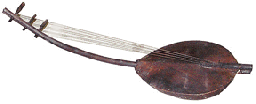

@rg
History Of Songwriting - Origins of Music

No one knows where the first song came from. Did Neolithic men sing around the first campfire? Did Adam croon a tune to Eve in the Garden of Eden? We may never know. Many believe that rhythmic chanting with percussive accompaniment from weapons may have been the first form of song. Prehistoric Rap? Well, sort of….
At some point, ancient people discovered that blowing across a hollow tube, like an animal bone or reed, produced a pleasing tone and that a string under tension (like a hunting bow) sounded pretty cool. An archeological dig in the Ukraine has uncovered 20,000-year-old flutes made of wooly mammoth bones — you won't find those at your local music store!
The First Song, the First Songwriter
Most songs and songwriters of the pre-Renaissance world have been forever obscured by time. Even after the development of musical notation, songs were mostly passed down through the generations by rote and modified to suit the changing times without reference or regard to the original songwriter.
We have no idea where the first song originated, who wrote it, what instrument was used, if there were lyrics, or what culture fostered its conception. What we can be sure of is that whoever wrote the first song probably had no idea of the importance of what was occurring, only that something wonderful was happening. That feeling is common to all songwriters, whether they are professionals or amateurs, rock stars, classical composers, Music Row hit-makers, or any other lucky soul who writes songs for fun or profit.
Tribal Music
Some of the first music happened in a tribal setting. Early tribes used drums and horns to communicate across long distances. Setting music in the context of a language and encouraging the development of a musical vocabulary probably hastened music development. Ancient people also used music for religious rites, festivals, and as a form of oral history.
Work Songs, Chanties, Marching Songs
One of the earliest song forms, worksongs, were sung to relieve the boredom of repetitive labor and provided a rhythm to keep a work crew in synch. One of the basic forms of the work song is the field holler, sung by farmers, serfs, and slaves while tending crops.
Work songs were usually written by the ordinary working people who used them. From these humble beginnings have sprung a wealth of past and present musical forms; work songs influenced most later musical forms. Today, historians find work songs a rich resource of information about the people and times from which they originate.
Another work song variant, the “chanty” was a favorite of sailors. To prepare a large vessel to sail, steer, drop anchor for the night, or make the ship safe from an oncoming storm requires large crews of people to work together in precise coordination. The sea chanty provided a rhythm to keep things running smoothly at times when a mistake could mean disaster for the whole crew.
You could say that marching songs are a subset of work songs. By establishing a beat, marching songs helped people walk as an organized group, thus moving more quickly and at a uniform speed. By setting a pace, marching songs allowed for precise timing in processions and parades. One of the most famous marching songs is undoubtedly "Yankee Doodle" , sung by American soldiers during the Revolutionary War. In many cultures, work songs are still a part of everyday life.

Very interesting. My best guess is that the first song sounded a lot like a wolf howling and the first instrument involved some guy beating a stick against a hollow log. Seriously, I think people and perhaps animals, are hard-wired to respond to musical sounds so the desire to make, listen to and respond to it is innate. All of us have seen babies rocking in time to music, a move no one ever taught them. It's another way we as human beings relate to one another and our place in space and time...
Excellent read and such an interesting touch of music history.
I'm fascinated that I ran into your article here by chance just after reading another article about music history. Th prior article I read was regarding the origin of the Son Clave rhythm pattern, and it's history.
I love the serendipity of finding both articles within 24 hours of another.
Thank you, I so enjoyed.